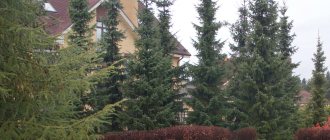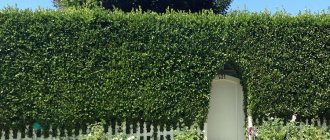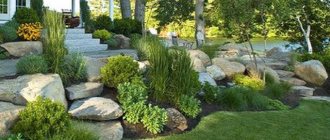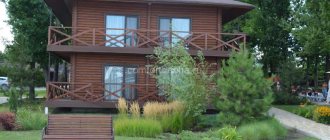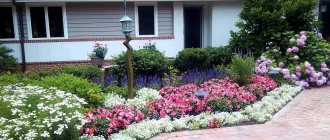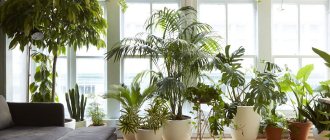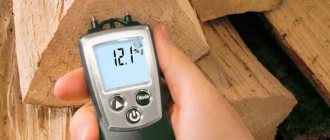A hedge is good if it is properly cared for, fertilized with special complexes, and planted according to the needs of the plants. It is very important to take into account the level, speed of growth, and the need for feeding. Modern gardens are often decorated with living plantings. The first place among candidates for planting living plantations is occupied by conifers. They are perfect for any landscape design, harmonize beautifully with the lawn in summer, look great against the backdrop of white snow in winter, always green, juicy, fluffy. Small country houses look very nice and cozy against their background; large mansions are given additional grandeur.
Thorny conifers protect the area thanks to their large needles, soft fluffy branches of juniper and thuja produce antibacterial phytocytes. In this way, plants help purify the air and debacterize it.
Coniferous trees and shrubs are quite expensive. You can try to grow it yourself, but it is very difficult to grow a pine cone from a cone, because the seeds germinate extremely slowly and poorly, so the surest option is to buy seedlings. However, given their price, it is better to immediately follow the technology of the planting process so as not to ruin the shrub. Otherwise, the hedge will not work, the money will be wasted.
Conifers for hedges: harvesting seedlings
Conifers are propagated by cuttings, carried out exclusively in greenhouses, because frost-resistant plants love warmth very much in the initial periods of their life. It is better to plan planting in early spring, when the buds are just swelling. During this period, vital juices reach their peak, which allows them to better “cling to life”, germinating more efficiently. There are two types of cuttings: lignified, green. Lignified ones grow faster, cuttings are taken in greenhouses in the fall and winter. Most of them take root safely after two to three months, if the watering and fertilizing system is properly balanced. Decorative forms are often grafted, but it is much more difficult for an amateur gardener to carry out such a procedure.
Features of planting a hedge of coniferous plants
The construction of a coniferous planting occurs in a similar way to the construction of ordinary fences, with a dug foundation and reinforcement. Before starting work, you should understand that thorny trees can interfere with passage, so you should carefully select seedlings and plan your planting plan more clearly. Only all materials are exclusively natural.
- It is necessary to mark the area where the fence will be located. Of course, you don’t have to take absolutely accurate measurements, similar to markings for fences; it’s enough to simply outline the territory, initially marking one line, then give it the shape of a trench that will be dug.
- The choice of location builds to organize, taking into account the needs of conifers. They grow poorly in strong shade; all biological species require sunlight for high-quality photosynthesis, but they burn out under direct rays. There are, of course, individual differences that need to be taken into account.
- It is recommended to dig one trench for all the trees at once. The task may seem difficult at first, but making individual holes will be much more difficult. It is also much easier to plant plants evenly in one dug hole. This method has the highest priority if seedlings are purchased at a time.
- The depth of the trench must be at least 70 centimeters. This question largely depends on the size of the roots. They cannot be twisted or bent too much, so you should dig a hole according to the comfortable location of the root system.
- The lower part of the “foundation” is drained with sand, maybe a little fine-grained pebbles. This will prevent stagnation of water, especially during cold periods, protecting the roots from rotting. Coniferous plants can be compared to house cacti - they are unpretentious, but they need water. Watering is organized systematically, approximately once a week.
- After preparing the hole, seedlings are planted. The minimum distance between plants is 80 centimeters; it is necessary to consider in the future the rapid increase in the size of the bushes, especially for trees. After planting, each tree (bush) is covered with earth and compacted. It is dangerous to press the ground too hard; you need to leave a little looseness to allow air to penetrate.
- Mulch is laid at the roots. There are different types: at the base of large plants you can fill in fine pebbles or old tree bark.
- The soil at the roots has to be lightly loosened from time to time so that the roots are better saturated without drying out.
- If the needles are on the sunny side in the hot summer, the needles may turn yellow. To avoid this, there are special aerosols that help the needles maintain their original appearance and prevent shedding. You can buy them at gardening stores, but they are quite expensive. A cheaper way is to cover it with ordinary burlap during the summer heat.
- In the southern regions, it is more important to plant in the fall, and in the northern regions in the spring. Plants with a closed root system are planted all year round.
Basic Rule
The basic principle of creating a mixborder is gradation. It is never even and symmetrical - this is why it looks so advantageous. There is an upper tier (of the tallest trees), a middle tier (of shrubs) and a low tier (of low-growing and ground cover plants). However, these levels can be located differently, depending on where exactly the flower garden is laid out.
Option one - Island
This is a flower garden located in an open area, usually in the middle of the garden, most often elongated, oval in shape. You can walk around it. Therefore, the upper tier will be located in the center - pyramidal and cone-shaped spruces, cypresses, yews and other conifers. They should be surrounded by lower bushes. Either thuja with juniper, or barberry with forsythia. Finally, at the very edge, near the border, you can plant decorative mountain pine, dwarf fir or small annuals.
Option two - Stairs
This is a flower garden located along a fence or wall. It is also elongated, but it is visible only from one side; it is impossible to walk around it. Therefore, the mixborder will descend towards the viewer along the stairs - from the top tier to the very last step. The principle of arrangement and selection of plants is the same as when decorating an island.
When planting conifers near a wall, take into account their powerful root system, which can damage the foundation of the building.
Feeding a hedge of coniferous trees
Conifers are unpretentious in many respects, until it comes to the soil. Ordinary fruit and berry trees in plots grow much more readily in unfed soil, adapting their rhizomes. Cypress trees, junipers, and thujas, on the contrary, compensate for the ease of care for them with a complex planting system.
- The soil for each plant is selected individually. Pines like sandy soil, spruce - clayey, junipers - slightly acidic. The same priorities include not wanting to grow in salty soil, the soil should be neutral.
- You should never fertilize conifers with manure; it burns the rhizome. Sawdust and natural compost are perfect.
- Nitrogen and phosphate fertilizers are useful. Young plants are fertilized starting in spring, including August; as they grow, the dosage must be increased.
- There are tablet fertilizers that are used once a year.
- Before the start of autumn, fertilizing stops, because the plants need to independently prepare for winter.
Good neighborhood
When creating a mixborder from conifers, you need to know what plants they are combined with. This affects not only the decorative properties of the flower garden, but also the health of flowers and shrubs, since they can negatively affect each other in close proximity.
Coniferous-deciduous mixborder
The combination of coniferous and deciduous shrubs and trees is especially beautiful in summer and autumn. Landscape designers recommend choosing plants with bright flowers and fruits.
Barberry Thunberg
Not only does it look good and gets along with conifers. They protect him from the wind. The most successful varieties:
- diamond-shaped Aurea - golden in spring and orange in summer (no more than 80 cm);
- columnar Erecta - bright green and bright red (1 m);
- spherical Green Carpet - juicy light green and reddish (60 cm);
- funnel-shaped, spreading Golden Ring - leaves are purple-violet with a crimson tint, golden-yellow border, flowers are yellow-red, fruits are scarlet.
Spiraea japonica
Often afraid of the sun and quickly withers in the heat. Conifers retain moisture in the soil for it and provide shade. Which varieties to choose:
- gray - spring-blooming, with snow-white inflorescences on long branches and grayish-green leaves;
- Nippon - spring-flowering, spherical, with white inflorescences (sometimes with red splashes) and green oval leaves;
- Golden Princess - spherical, squat, with lilac or pinkish flowers, collected in round inflorescences, and light green jagged leaves;
- Little Princess is spherical, with bluish-green oval-elongated foliage and light pink flowers.
Forsythia
It looks like a bright yellow spot in the coniferous mixborber, drawing the eye to the flower garden. Recommended varieties:
- European - with single bell-shaped yellow flowers;
- drooping - spreading, with small golden flowers collected in inflorescences, dark olive branches;
- dark green - with rich green jagged leaves and green-yellow flowers, collected in small bunches;
- snowy - with oval leaves that have a purple underside; in autumn the foliage becomes purple, the flowers are large, white with a yellowish throat and a light pink center.
To create a bright, beautiful mixborder of shrubs and conifers, the former must be distinguished by either bright green foliage against the background of lush green spruce and cypress trees, or beautiful flowers, or expressive fruits.
Mixborders with conifers and perennials
Such flower beds are suitable primarily for those who do not have time to care for them every day, if you manage to visit the site once every 2-3 weeks and then only on weekends.
Roses
The most luxurious is considered to be a mixborder made of conifers and roses. The juicy needles and incredibly beautiful buds look great. Which varieties are suitable:
- compact bush;
- hybrid tea;
- climbing;
- polyanthaceae;
- ground cover;
- remontant.
However, remember that of all perennials, roses require the most care. In particular, they need to be trimmed and supported in a timely manner. And another difficulty in creating such a mix is that these flowers love the sun, while conifers love the shade. Therefore, you need to carefully look for a place to locate a flower garden, and the plants themselves should not be planted close to each other.
Hydrangeas
They create a noble mixborder in which, in principle, no other plants will be needed. Recommended:
- spreading and compact Anabel with spherical white flowers;
- spherical Grandiflora with flowers that change their color several times: light green - white - cream;
- round Sterilis with dense inflorescences, which during the summer change shade from greenish to white;
- paniculate fan-shaped Kuishu with ovate beautiful leaves and white flowers.
Hydrangea uses the proximity of conifers to its benefit, as they provide it with the moist soil that it loves so much.
Chrysanthemums
Here you need to know a couple of nuances:
- It is better to plant low-growing varieties of chrysanthemums next to creeping and ground-cover coniferous plants;
- and vice versa: tall, bush-like chrysanthemums - with pyramidal and cone-shaped coniferous trees;
- Usually spherical varieties of hydrangea are chosen;
- White, yellow and red varieties of chrysanthemums should be planted against the background of green conifers.
Indian, Korean, autumn, prominent, seeding and odorless chrysanthemums look good.
With annuals
Such mixborders can be created only by those who have time to care for annual flowers, which require regular watering, fertilizing, loosening the soil and other useful procedures. Which ones are suitable:
- balsam that blooms brightly until frost: New Guinea garden, Hokera, large-flowered, creeping, Camellia, Impatiens Waller;
- marigolds with their variety of shades from bright sunny to deep burgundy;
- hybrid verbena - with small but bright flowers of a wide variety of shades - blue, purple, red, white, pink, blue, peach.
For the first tier of a mixborder with tall conifers, annuals such as asters, violets, pushkinia, galanthus, bells and irises are also suitable.
Mixborder of conifers and cereals
This is a classic of the genre, allowing you to eliminate bright spots in the garden, which sometimes irritate the eye with too lush flowering and a variety of shades. Only greens - and nothing more. The following cereals are suitable:
- gray fescue;
- Pogonaterum millet;
- Italian setaria;
- maned barley;
- cortaderia;
- pinnately bristly, American, shaggy;
- miscanthus;
- haretail.
A particularly interesting ensemble is obtained from any of the cereals with various varieties of decorative juniper.
Watering a conifer hedge
Coniferous crops are moisture-resistant, tolerate drought normally, but are much worse affected by excessive watering. That is why small drainage layers and sand cushions should be laid to facilitate better removal of moisture from the roots. These measures prevent rotting and the occurrence of fungal plaques. It is especially important to systematize the irrigation process during the period of active growth.
- Vegetation is an important part of the active process of rooting, “maturing” of a tree or bush. This can be seen in the number of new young light green shoots that need to be carefully kept away from direct hot sunlight. The branches are filled with juice and are most vulnerable during this period. During this period, which occurs more often in the spring, you should increase watering, leave several per week, and by autumn reduce it to one good watering per week.
- It is necessary to water especially carefully in the summer; the average duration of watering during this period is several hours; with the onset of cooler weather, this time is reduced, along with the number of waterings.
- Many coniferous varieties love moist air. That is why they grow well in park areas and on private plots of coastal areas. The soil there is saturated with sandstone and the air is moist. To create such conditions artificially, you can spray with plain water using a spray bottle. It is advisable to carry out the spraying procedure in the evening. Droplets of water work like lenses, so in hot weather it can cause burns; if you water after sunset, the water will drain worse, and fungal deposits may form.
- Mature trees tolerate dry soil, although complete drying out is completely undesirable.
Rules and principles of design
A mixborder of conifers and shrubs (planting schemes must be thought out before creating a flower garden) begins with developing its scheme and selecting plants according to height, color, and growing conditions. It is taken into account that they will be planted in tiers so that the highest object is at the farthest point from the viewer.
In one composition:
- It is not recommended to use more than 3 shades of pine needles. This will create excessive, unpleasant to the eye, variegation;
- it is necessary to take into account that coniferous trees give the mixborder rigor and respectability. You should not complement it with plants with overly bright flowers or wide leaves, which will add a touch of vulgarity, spoiling the overall impression;
- of coniferous trees and shrubs, it is advisable to avoid precise geometric lines and right angles: a mixborder with smooth, “irregular” curves looks more natural.
At the same time, the coniferous composition must have clear boundaries, which are created using fencing. Another option is to mulch the soil with gravel and crushed brick tiles. Mulch will not only create the desired effect by changing the color of the soil, but will also make it easier to care for the mixborder, inhibiting the growth of weeds and helping to retain moisture.
Another frequently used decorative element is stones scattered in apparent “disorder.” Lamps will complement the composition and make it even more impressive, provided that they are well selected and correctly positioned.
Island
A mixborder island is a flower garden located in an open space, usually in the center of the garden. Since there should be no plantings or buildings in the immediate vicinity of the “island,” this is an option for a large area: in a cramped area it will lose its charm.
It is also important to comply with the basic requirements:
- The best shape for an island flower garden is considered to be an oval. It is not necessary to try to achieve geometric accuracy: slight negligence will make the composition more natural;
- When choosing sizes, it is recommended to adhere to the following rule: the width of the mixborder should be equal to 1/2 of the distance from which it is visible. For example, for a flower garden that is located 4 m from the entrance to the house, the optimal size is 2 m;
- the larger the size of the mixborder, the higher the tree, which is the center of the composition, should be;
- the middle tier is located in a ring around the central element at some distance from it;
- trees of the lower tier are planted closer to the edge so that their crowns cover the trunks of plants growing behind them;
- the space around the perimeter can be filled with ground cover plants.
The composition will be complemented by stones, garden sculptures, and decorative lanterns.
An island flower garden must have clear boundaries.
Can:
- place it slightly higher than the adjacent area, creating a fence of stones;
- achieve the desired effect by mulching the soil.
One of the advantages of the “island” microborder is ease of maintenance: the flower garden is open on all sides, so any area of it is accessible for weeding, pruning, and watering. At the same time, it is difficult to find an area that is in partial shade and does not have any large objects in the immediate vicinity.
Ladder
A mixborder of conifers and shrubs (stair-type flower bed designs involve cascading plants); the staircase is usually laid out near a high wall or fence. Trees of the upper tier are planted directly in front of it, followed by plants of the middle and lower tier, and ground cover varieties complete the composition.
The basic principles of the “ladder” are:
- the flower garden usually has a very elongated shape, its minimum width is 1 m;
- the height of the elements of the composition is selected in such a way that specimens growing in a lower tier cover the trunks of plants located behind them;
- the height of the trees in the upper tier is slightly lower than or equal to the height of the fence or wall near which the mixborder is located;
- like the flower garden-island, the “staircase” should be clearly limited along the front edge: for this purpose, height differences or low fences are used.
The “staircase” flower garden is an excellent solution for:
- small areas;
- designing the area along the pedestrian path;
- camouflage tall objects that are not particularly attractive.
Another advantage is the ability to easily provide conifers with partial shade and protection from the wind.
Disadvantages include the difficulty of caring for plants. Since the flower garden is only accessible from one side, reaching the trees in the upper tier will not be easy.
Trimming living fences made of coniferous plants
Trimming freshly planted trees is not recommended. It is only possible to trim the bushes on the sides; it is better to leave tall species for several years of quiet growth. If the tree is ready in all respects and is growing well, it is better to trim it with special pruning shears in spring or autumn.
- If they have reached the age of three, cut off the top by a third of the annual growth. Spruce plantings are perfectly pruned and usually feel good after pruning. The main thing is not to trim more than necessary.
- Pine trees are pruned in May and early summer, by pruning into rings. This is due to the appearance of young growth during this period. This type of pruning is associated with the appearance of inactive buds. The tree spends its vital juices on them, which it could spend on younger shoots. By carefully cutting off non-growing shoots, new buds gradually appear, forming fresh shoots. This process is also called plucking. Along with pine trees, it can be carried out in the spring.
- Hedges grown in free form, without pruning, are very susceptible to breaking the tops. You especially need to monitor this in winter if there is a lot of snow. It is shaken off the tops of the heads, the tops themselves are trimmed a little. This operation is related to the location of the fault. By cutting off a little of the top in advance, you can save the entire branch.
When cutting your hair and adding texture to your appearance, the main thing is not to “grab” too much, otherwise it will go up even more slowly. Coniferous species are very gentle towards shoots and buds, so it is generally better to avoid the vegetative period.
Diseases of coniferous plants
The plants described by the species are very unpretentious, but they are also loved by various diseases and are periodically attacked by pests.
- The most famous garden enemy is aphids. In the spring, with high soil moisture not associated with watering the garden by the gardener, favorable conditions are created for the life of this insect. If the problem is not caught in time, trees and shrubs can be seriously damaged. Spraying with decis diluted in water helps, sometimes it is replaced with fastak.
- A major challenge is the formation of rust. This is a special type of orange plaque that affects trunks and sometimes branches. The disease spreads from mountain ash, pear, and hawthorn, so it is better to immediately plant these trees and bushes further away. If an infection has occurred, you can try to remove it with saprol, dithane, spraying with solutions according to the instructions.
In general, there are few diseases, which is why hedges made of coniferous plants are very popular. There are rows of wood mites, molds that can overcome trunks, branches, even fruit. Additionally, prevention can be carried out to prevent the occurrence of diseases; sometimes gardeners act based on the current situation. It is difficult for non-professionals to immediately guess which trees to plant nearby and what to spray with. Conifers are good for their longevity and slow reaction, so you can try to save a diseased tree.
Types of conifers for hedges
It is difficult to find fast-growing varieties of conifers adapted to any environment. A hedge becomes an excellent addition to a site when the seedlings are at the right distance and the species are perfectly selected. It is much easier to combine areas that can be formed without human intervention. Of course, almost all conifers planted separately look great. Some are much better at making hedges. Below are the most popular types of conifers:
- Prickly spruce forms impenetrable thorny hedges and grows widely, so it is advisable to plant it at a distance of up to 1 meter. It grows slowly and tolerates urban conditions well. The needles are blue, with a silver tint.
- Norway spruce tolerates shearing well, but if planted at intervals of forty centimeters, the hedge will be so dense that it can practically not be trimmed. It grows slowly in the first decade, although otherwise it is the best planting for a hedge.
- The common juniper has soft fluffy branches, grows up to 10 meters - it is perfect for hedges, low-growing forms complement borders. Low exposure to pests.
- Virgin juniper tolerates pruning well, retains its shape for a long time, only the sides are pruned. The dark blue cones look great and give the hedge a richer appearance.
- Cossack juniper is more of a border, low-growing type. Suitable for single-row plantings due to the wide crown. Requires a minimum planting density of about forty centimeters.
- Western thuja maintains its shape for a long time, it is planted close, also about forty centimeters. Reaching seven years of age, the branches become denser, intertwining into one large hedge.
- Oriental thuja has soft needles and fluffy branches. Characteristic for the most arid regions due to its endurance.
- Yew berry is considered the best material for topiary art. Perfectly withstands any, even the most complex, shaping haircut. The forms can be high, used instead of fences, or low, complementing borders. It grows very slowly, less than three centimeters annually. At the same time, it is durable and unpretentious. Tolerates bad city polluted, dusty air. Resistant to pests and diseases.
Along with formed hedges, free-growing hedges are popular. Accordingly, the plants must stretch straight on their own, without constant care or trimming. These qualities are mostly possessed by:
- Gray conical spruce , planted at 1 meter intervals, forms beautiful living, thorny green fences. Mature plants are very lush. The crown is beautiful, with a classic pyramidal shape. At the same time, the dimensions are significantly small, stretching up to a maximum of six meters. Drought-resistant, light-loving, adapts well to arid soils. Prefers good drainage, slightly acidic soils. Sometimes it is damaged by aphids and wood mites; both diseases can be cured on your own.
- Siberian fir creates entire living walls. In the spring, imports are formed, which turn into purple cone berries closer to summer. Prefers medium moisture soils saturated with fertile enzymes. They are disease resistant and grow well in coastal areas.
- Mountain pine is more suitable as a complement to borders and low hedges. Trimming does not produce additional branching growth. Seedlings are planted at a half-meter distance, are drought-resistant, undemanding about the type of soil, and live well in an urban environment. The flowering period is associated with the formation of pink and yellow strobiles.
By what criteria are trees selected for this purpose?
The selection of species that will make up a hedge is made according to several criteria.
Height
The division by height is somewhat different from that accepted in botanical classifications; this is due to the conditional division of the hedges themselves into low (up to 1 m), medium (1-1.5 m) and high (more than 1.5 m).
Consider using trees:
- Tall (height more than 1.5m). They are suitable for single-row high fences or as the top tier in multi-row multi-tiered ones.
- Medium height (1-1.5m). Such trees are used to form medium-height hedges or a middle tier/row for multi-row/multi-tiered planting. As a rule, very slow growing or dwarf forms are used.
- Low-growing (up to 1 m). They are part of low fences or lower tiers with a multi-tiered method of their formation. Shrubs are more often used for this purpose; of mature trees, only some dwarf forms are suitable.
It is possible to create a low hedge only from young trees at the initial (during the first few years) stages of growth with replacement as they mature.
Growth rate
Trees are considered on this basis:
- Fast-growing (20-25 cm or more, some - over 1 m) per year.
- Slow growing (less than 20 cm per year).
As a rule, landscape designers consider the use of fast-growing species to implement a camouflage function - in living walls to fence an area or as an upper tier in a multi-tiered planting.
To perform fencing functions (preventing entry into the site), trees with a growth rate from very low (literally 0.5-5 cm per year) to low are more suitable.
Ability to tolerate pruning
In trees that tolerate pruning well, after pruning, dormant buds awaken and new internal shoots form.
This leads to thickening of the crown and stable retention of its given shape. These species are well suited for molded hedges.
Species that do not meet this requirement tend to form free-growing fences.
When choosing plants for hedges, their other properties are also taken into account:
- Decorative appearance and the ability to maintain it all year round.
- Demanding requirements for soils and fertilization.
- Need for constant care.
- Resistance to environmental conditions - frost, drought, gas pollution and dust in urban air, etc.
However, first of all, most often, they consider whether trees belong to the groups of evergreens (usually conifers) or deciduous plants.

